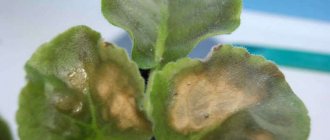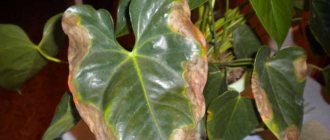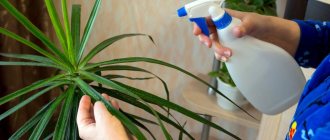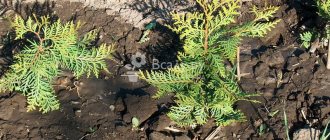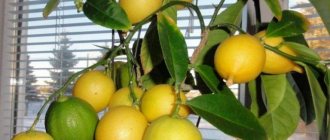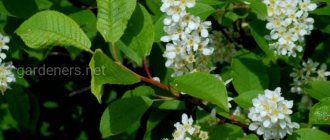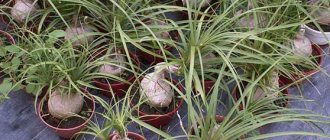Exotic cultures are often famous for their beautiful and unpretentious “character”. But, unfortunately, palm diseases at home cannot be called rare. Such a tragedy in the life of a plant is a consequence of improper maintenance of the flower. Therefore, the main task of the gardener should be to create a favorable microclimate, as close as possible to the tropical one. Initially, you should take care of air humidity, since the heat-loving tree does not tolerate dryness around the green mass. In 9 out of 10 cases, this is what leads to death.
Leaf dying is a natural process for most plants. In a palm tree, these scars form a majestic trunk. Nevertheless, its indoor varieties should be kept in a green state for as long as possible.
Carrying out preventive measures will help protect a small greenhouse from the harmful effects of pathogenic microorganisms. However, there are situations when plants still show signs of serious illnesses. Then you need to look for the reasons for their occurrence, and then organize a competent treatment session.
Pests
Of the indoor pests, palm trees are most often attacked by sucking insects such as thrips, spider mites, mealybugs and scale insects. By sucking out the cell sap from the plant, they disrupt the physiological processes in the plant tissues, as a result of which the growth of the plant slows down, it loses its decorative properties, since the leaves lose their green color, and if severely damaged, it dies. Dry indoor air combined with a fairly high temperature promotes the proliferation of insect pests.
- Shield. The most common pest on palm trees. Settles on leaves and petioles, especially often on young ones. The insect larva, attaching to the plant, loses mobility and becomes covered with a waxy shield about 2 mm in diameter. Initially soft and light, over time the shield hardens and acquires a brown color. Yellow spots appear on the leaves where the insect feeds. Young leaves affected by scale insects cannot develop normally. They often dry out and die. A sooty fungus very quickly settles on the sugary secretions of the scale insect, which further pollutes and weakens the plant.
Rigid shields reliably protect insects hiding under them from the effects of pesticides. Therefore, leaves affected by scale insects are cleaned of insects manually with a thin brush or narrow wooden stick. In case of severe damage, the leaves are washed with soapy water (1 tablespoon of liquid soap per 1 liter of water), after covering the earthen ball with a film to prevent soap drops from falling on the ground. The next day after this treatment, wash off the soap scum with water.
— Mealybug . A sucking insect 3.5 mm long, clearly visible to the naked eye. Settles on the underside of leaves and in leaf axils. The female secretes thin white waxy threads, from which she forms a cotton-like mesh for the larvae. Adult insects and larvae, sucking out cell sap, thereby weaken the plant and, in addition, pollute it with their secretions. When they secrete abundant honeydew, a sooty fungus settles on the leaves, severely polluting the plants.
- Trips. A tiny insect with a narrow dark brown body 1-1.5 mm long and two pairs of wings, usually settles on the underside of leaves. From the eggs laid by the female in the leaf tissue, wingless larvae hatch after 8-10 days, initially white, later turning yellow. Due to the sucking of cell sap by both adults and larvae, yellowish-brown spots appear on the underside of the leaves, and the leaves become whitish on the top. Severely damaged leaves turn yellow and dry out. The small black droplets noticeable on the leaves are nothing more than the excrement of insects and larvae.
If the damage is mild, it is enough to water the palm tree thoroughly, wrap it in transparent plastic wrap and put it away from the sun. High air humidity under the film will cause insects to die. In case of severe damage, the palm tree should be treated with infusions of tobacco, dandelion roots, and celandine diluted in water. As a last resort, you can resort to commercially available ready-made chemicals, but using them in residential areas is dangerous.
— Spider mite . A very small insect, not visible to the naked eye, 0.2-0.4 mm long. Its appearance is indicated by thin cobwebs on the underside of the leaves, where the female lays her eggs. As insects and their larvae suck out the juice, numerous punctures appear on the leaves, the leaves become severely discolored, and in case of severe damage, they dry out and die. Hot and dry weather contributes to the mass reproduction of ticks.
Control measures are the same as for thrips. In addition, it is recommended to spray plants affected by spider mites with water as often as possible or even immerse them entirely in water for several hours. Spider mites do not tolerate water, and a wet bath is very effective against them. In case of severe damage, you can use herbal or chemical acaricidal preparations. Recently, more and more people have begun to abandon chemical methods of controlling mites and resort to the biological method, planting a predatory mite on plants - phytoseiulus, which destroys the pest.
Chemicals for mealybugs
The easiest way is to use special tools. Usually they have a complex effect, so they will also help against other uninvited guests. In addition, modern formulations contain various useful components for indoor plants, so stereotypes about terrible chemicals have long had nothing to do with reality.
Fitoverm
This is a very popular, effective and low-toxic drug that is ideal for indoor plants. Due to its biological origin, it poses virtually no threat to humans and pets. To use, you need to dilute the concentrate with water and spray the plant. Usually the procedure needs to be repeated up to 4 times, but be sure to follow the instructions.
Photo: nn-sp.ru
Aktara
This is a complex insecticide that is also used for spraying. It can also be bred for irrigation against root pests. For greater reliability, we recommend combining both methods and repeating the procedure 2-3 times.
Photo: domashniecvety.ru
Biotlin
This is a contact-intestinal insecticide that was originally developed for garden plants. But it also shows excellent effectiveness against mealybugs. The active substance in the composition is quite dangerous, so carefully follow the dosage and precautions.
Photo: vseprodachu.ru
Confidor
This drug is completely harmless to indoor plants, but the pests die within a few hours. It is found in the form of granules and liquid concentrate. You need to dilute it in settled water and spray the plant along with the soil. A weaker solution can also be used for watering.
Photo: sadim.guru
Aktellik
This is a strong concentrated drug that is most often found in ampoules. It has a number of contraindications, and you can only work with it outdoors, so you will have to take the flowerpots to an unglazed balcony or street. But Actellik is very effective in cases of severe and advanced lesions.
Photo: sazhaemvsadu.ru
Did you like the post? Subscribe to our channel in Yandex.Zen, it really helps us in our development!
Fungal diseases
Palm trees are affected much less frequently by fungal diseases. This usually happens when the plants are kept too cool and at the same time damp in a poorly lit room.
— Grafiola, or date smut. Affects date palm and chamerops. Brown “warts” appear on the leaves, from which a mass of spores emerge. Severe damage by graphiola leads to complete yellowing and death of the leaves. Diseased leaves must be removed and burned, and the palm tree must be isolated from other plants and treated with approved fungicidal preparations.
- Oily spotting. The disease, caused by different types of fungi, is expressed in the appearance of oily spots of different sizes, shapes and colors on the leaves. Spotting develops in conditions of high humidity.
- Penicillosis. It is caused by a fungus that settles on the growth cone of the stem and in the leaf sheaths, where a pink coating appears. The fungus develops successfully in conditions of lack of light and elevated temperature when water comes into contact with the growth point. Areas affected by the fungus turn brown and die, which ultimately leads to the death of the entire plant. To avoid disease, it is necessary to maintain optimal conditions for palm trees, and to reduce the spread of the disease, remove affected leaves.
Preventing plants from mealybug
Mealybug prevention is extremely simple. New flowerpots must be quarantined separately from other indoor flowers for at least a couple of weeks. It is advisable to treat them with antifungal drugs and insecticides at the same time.
It is imperative to keep the flowerpots clean and tidy and remove dry leaves and shoots in a timely manner. And also wash and spray those flowers that need it. After all, flower shops sell special fertilizers in sprays with protective additives.
Photo: landas.ru
Diseases of indoor plants: names, photos and how to deal with them
Non-communicable diseases
— Drying of leaves . It begins with browning of the tips of the leaves, which then covers the entire leaf area. The reason may be dry air in the room, a sudden change in the maintenance regime, for example, moving a plant from a greenhouse to a living room, as well as rotting of the roots as a result of stagnation of water in the pot due to clogging of the drainage hole in the bottom of the pot or accumulation of water in the flowerpot.
— Sunburn . If a plant stands on a balcony in the spring, unprotected from direct sunlight, unsightly burn spots with brown edges appear on the leaves.
— Yellow spotting . It may appear on the leaves when the earthen ball is over-moistened and overcooled or when the substrate is too dense and does not allow air to pass through to the roots. Such a palm tree must be kept on dry land, and when watering, use warm (not lower than 22 degrees) water.
It is absolutely clear that it is much easier to prevent a disease than to fight it later. To do this, you need to provide the plant with proper maintenance and care, i.e. free placement that does not interfere with air circulation, plant cleanliness achieved by regular washing, as well as optimal temperature and humidity conditions.
pest control products
If you still had to resort to chemicals, you must remember that they are all poisonous to humans to one degree or another, often have an unpleasant odor and their use in rooms is dangerous. In addition, before treating the plant with any chemical, it is necessary to check on a small area of the leaf how the plant reacts to it, whether it will harm the palm tree. Knowing the disease or pest, you can prevent the death of the plant. Good luck to you.
Popular palm diseases at home
All problems begin with improper watering. Although the culture really needs life-giving moisture, but not too much. Otherwise, an irreversible decomposition process will begin. There is another extreme - overdrying the soil. Eventually the foliage becomes pale, becomes mottled, stops growing and withers. But these are only some of the manifestations of diseases. Now you need to remember what they can be and how to save your own “beauty” from them.
The main rule of care is daily spraying. However, the sheets should be washed occasionally. This is done very delicately, since in certain varieties the greens are covered with a waxy coating/fluff (manifestation of a defense reaction). If you erase it, the leaf will die. The liquid temperature should be no more than 30°C.
Brown "scourge"
Very often, flower growers begin to sound the alarm when brown spots appear on palm leaves. Pigments are distinguished only by their shape and size. The spotting process begins with small round formations. As they progress, they become larger in diameter, acquiring angular contours. This happens for the following popular reasons:
- water stagnation in the soil or waterlogging;
- use for irrigation of hard and also cold water;
- low temperature in the holding room.
Features of representatives of the palm family
As practice shows, most of the ailments of these unusual plants are associated with improper care or inappropriate conditions. After all, even the most persistent and uncapricious palm tree remains a tropical guest, accustomed to a certain climate. And every gardener who decides to plant such a tree must study its needs and create favorable conditions as close as possible to natural ones. It is worth paying attention to the following points:
It should be high; most palm trees do not tolerate dryness well. Most often, this is the cause of disease and death of exotic plants.
- Natural leaf dieback
For all representatives of the flora that have foliage, this process is the norm. But in a palm tree, the scars that remain in place of the petioles are necessary for the full formation of the trunk. However, it is desirable that indoor palm trees keep their foliage as long as possible and remain green.


